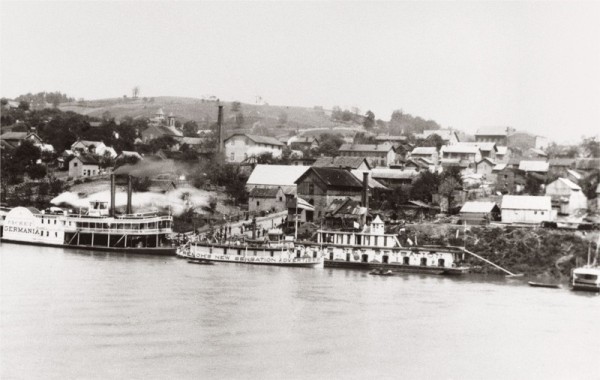
Photograph, Morgantown, West Virginia, ca. 1870. View of Lot 1 at the wharf on the Monongahela River. (Courtesy, West Virginia and Regional History Center, WVU Libraries.)

Jar, attributed to David Greenland Thompson, Morgantown, West Virginia, 1854. Salt-glazed stoneware. H. 10". Inscribed on shoulder: “First 2 jar for Francis Madiera June the 2nd, 1854.” (Duez Collection; unless otherwise noted, photos by Gavin Ashworth.) Francis Madiera was the postmaster in Morgantown at that time. The same cobalt script “M N” (for Morgantown) occurs on two pieces made by David Greenland Thompson.

Details of the inscription on the jar illustrated in fig. 2.

Newspaper announcement, The Monongalia Mirror (Morgantown, Virginia), July 22, 1854, p. 2 (reproduced). (Courtesy, West Virginia and Regional History Collection, West Virginia University Libraries.)
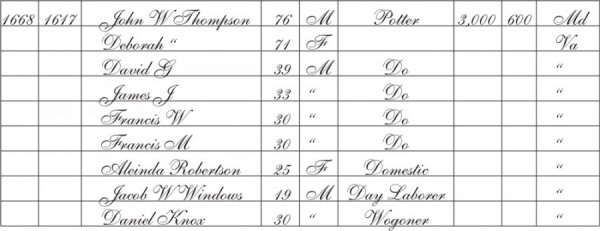
Population census, Monongalia County, Virginia, 1860 (reproduced). The original document, which is accessible online through www.ancestry.com, lists the owner of the pottery shop, John W. Thompson, and his four sons as “potter.”
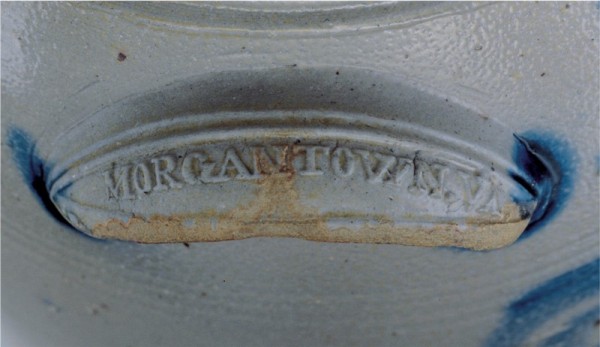
Detail of the handle on a 15", 4-gallon stoneware jar. Mark, embossed on handle: MORGANTOWN, VA. (Duez Collection.)

Map of Greene and Fayette Counties, Pennsylvania, illustrated in Caldwell’s Illustrated Combination Centennial Atlas of Greene Co. Pennsylvania (J. A. Caldwell, 1876). (Duez Collection; photo, Dick Duez.) Uniontown, Greensboro, and Morgantown share regional proximity.
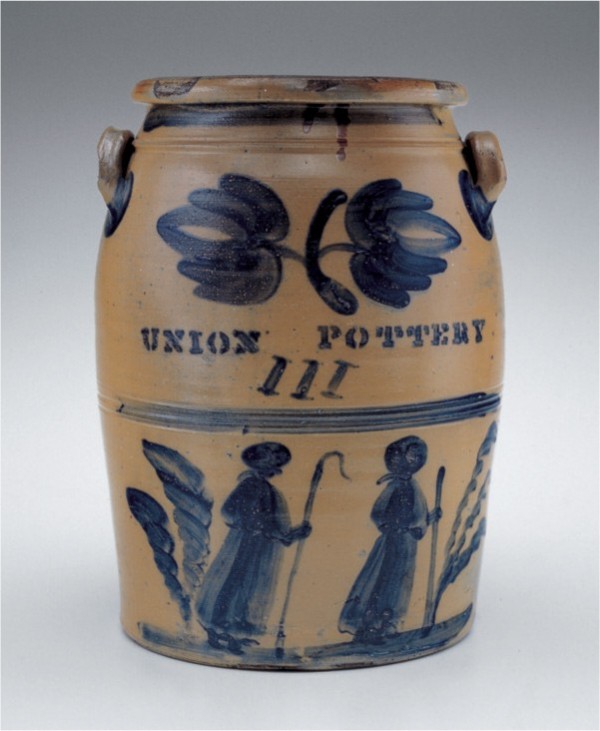
Jar, Union Pottery, Uniontown, Pennsylvania, ca. 1870. Salt-glazed stoneware. H. not recorded. Marks: UNION POTTERY / III. (Private collection.)
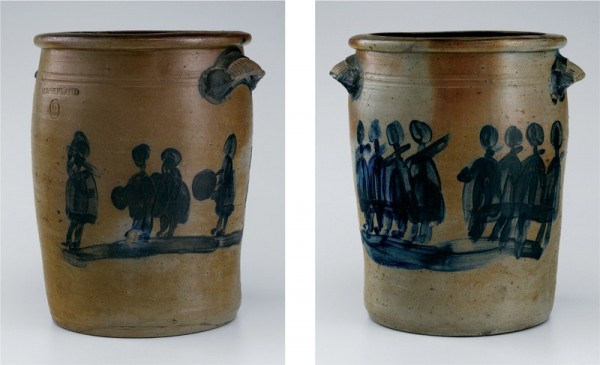
Jar, Union Pottery, Connellsville, Pennsylvania, ca. 1865. Salt-glazed stoneware. H. 12 3/4". Marks: impressed on shoulder, J. GREENLAND; 3 [gallon capacity stamp]. (Private collection.) The cobalt decoration depicts a marching band of soldiers wearing great coats and kepis.
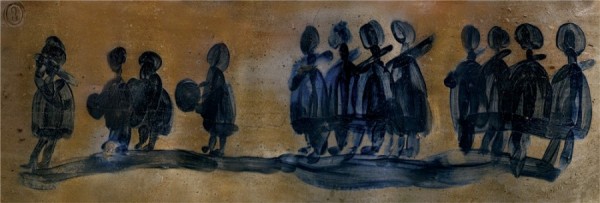
Detail of the decoration on the jar illustrated in fig. 9; composite image of cobalt designs on the jar.
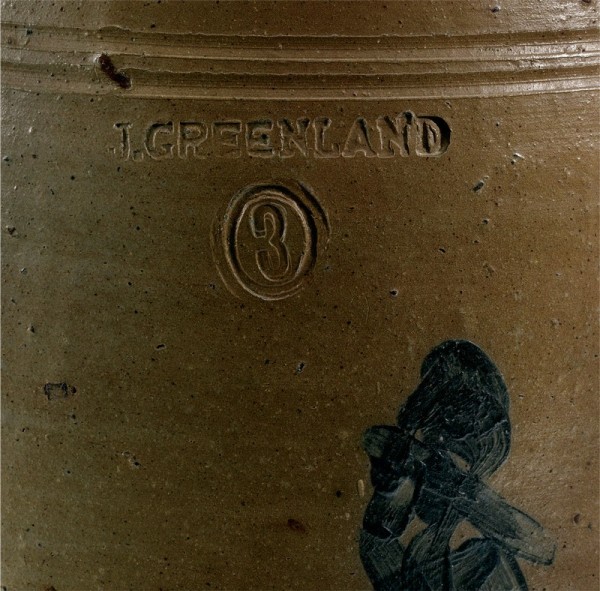
Detail of the impressed marks on the jar illustrated in fig. 9.

Jar, David Greenland Thompson, Morgantown, West Virginia, 1870. Salt-glazed stoneware. H. 15". Marks: impressed on shoulder, D. G. THOMPSON; 4 [gallon capacity stamp within a beaded circle]; Morgantown. (Duez Collection.)
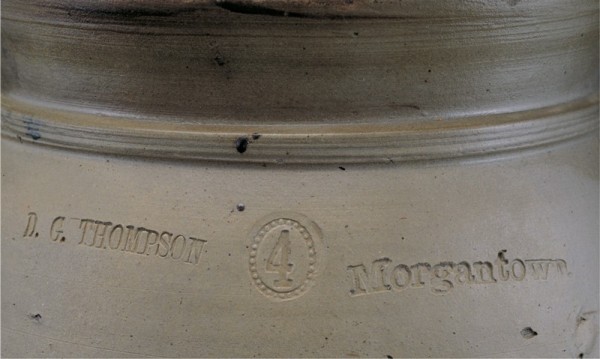
Detail of the marks on the jar illustrated in fig. 12.
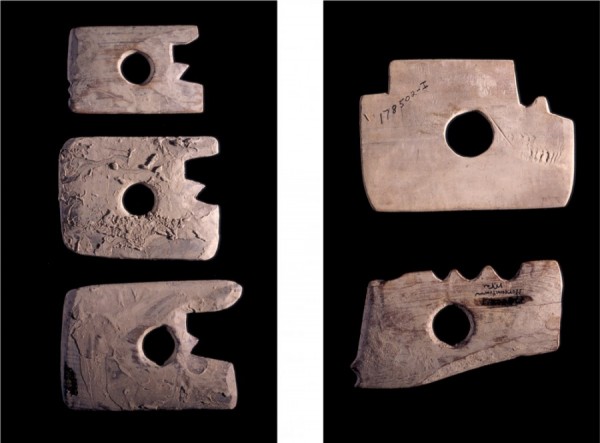
Ribs, Thompson Pottery, Morgantown, West Virginia, 1850–1870. Wood. (Courtesy, National Museum of American History.) These ribs would have been used to make the heavy rims of the crocks and other pottery pieces.
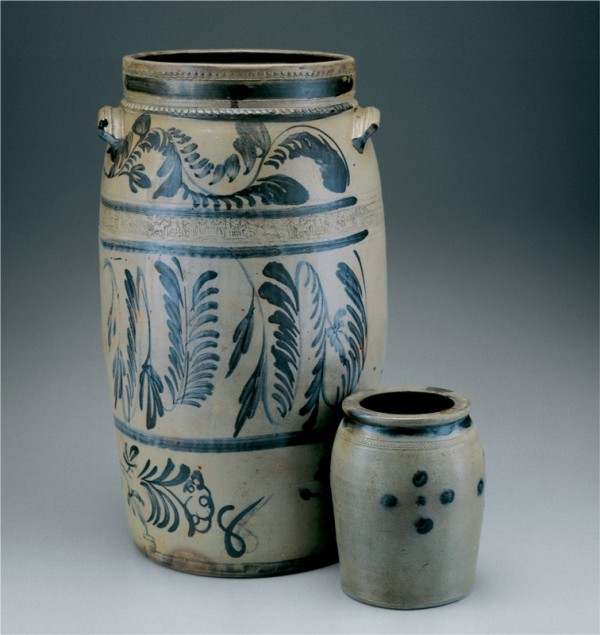
Jars, Morgantown, West Virginia, (left) ca. 1865, (right) ca. 1860. Salt-glazed stoneware. H. (left) 20 1/2", (right) 7 1/2". (Duez Collection.)

Crock, Morgantown, West Virginia, ca. 1870. Salt-glazed stoneware. H. 7 1/2". (Private collection.)
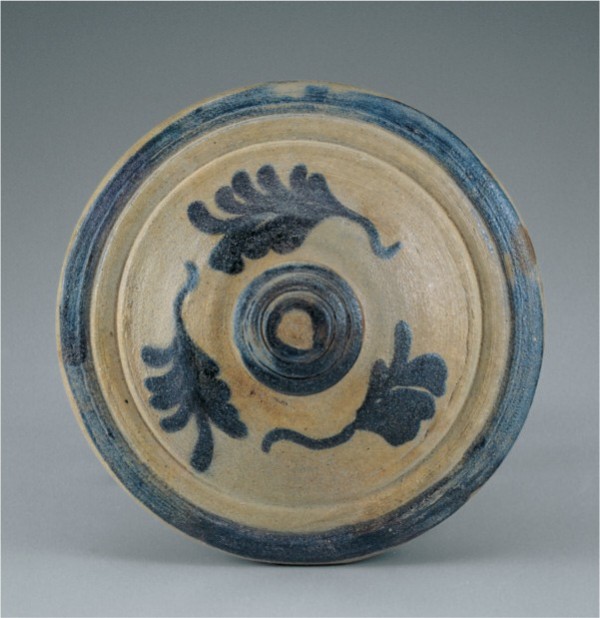
Crock lid, Morgantown, West Virginia, ca. 1870. Salt-glazed stoneware. D. 7". (Duez Collection.) This is the only known example of a stoneware lid made at Morgantown. It was found in three pieces at the Morgantown wharf.
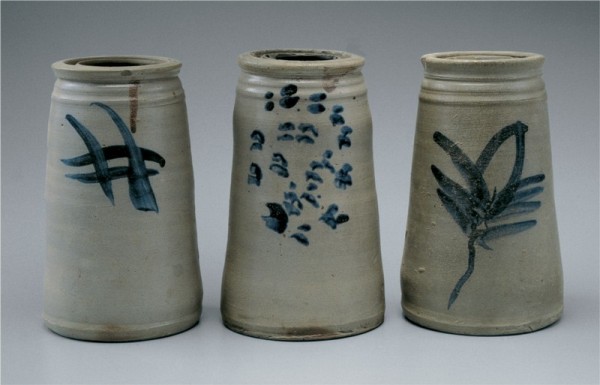
Preserve jars, Morgantown, West Virginia, ca. 1870. Salt-glazed stoneware. H. (left to right) 8 1/2", 8 5/8", 8 1/2". (Private collection.)
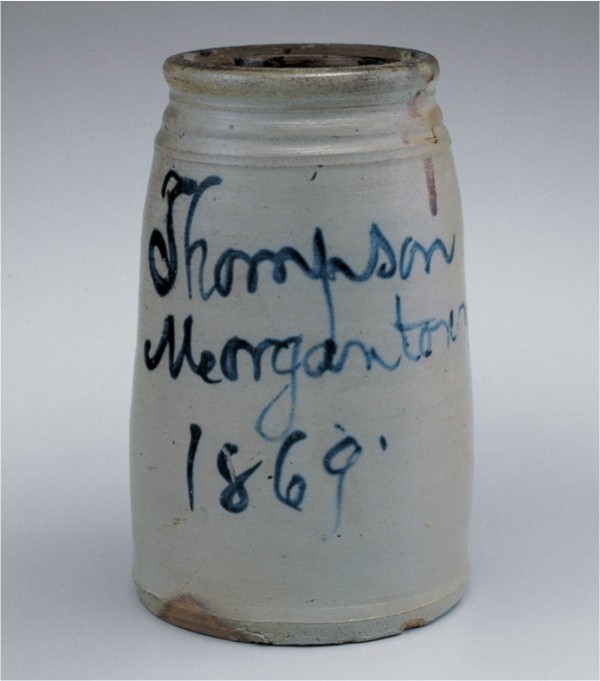
Preserve jar, attributed to David Greenland Thompson, Morgantown, West Virginia, 1869. Salt-glazed stoneware. H. 8 1/2". Marks, inscribed on side in cobalt blue: Thompson / Morgantown / 1869. (Duez Collection.) This piece might have been made to commemorate David Greenland Thompson’s fiftieth birthday.

Bottle, Morgantown, West Virginia, ca. 1860. Salt-glazed stoneware. H. 13 1/2". (Duez Collection.)
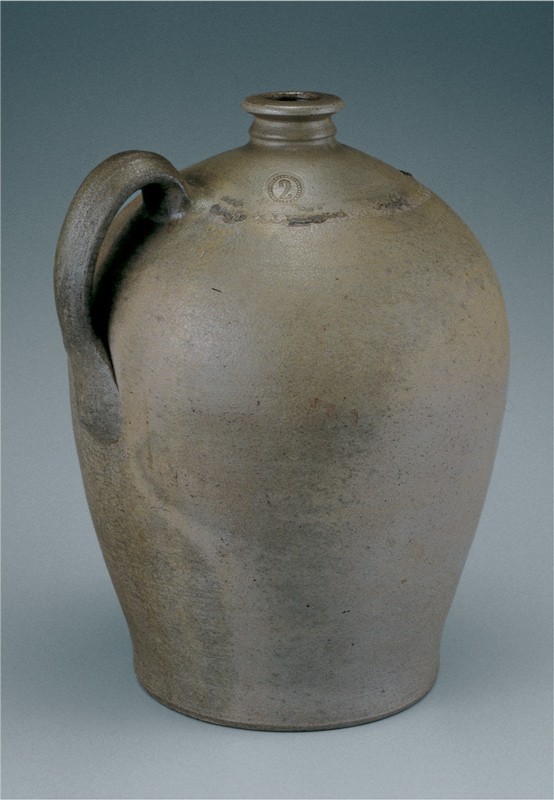
Bottle, Morgantown, West Virginia, 1854–1860. Salt-glazed stoneware. H. 12". Mark: 2 [gallon capacity stamp within a beaded circle]. (Duez Collection.) This bottle, which was found in Daybrook, Monongalia County, West Virginia, has a rouletted pattern on its shoulder (see fig. 22).

Detail of the top of the bottle illustrated in fig. 21, showing the rouletted decoration.
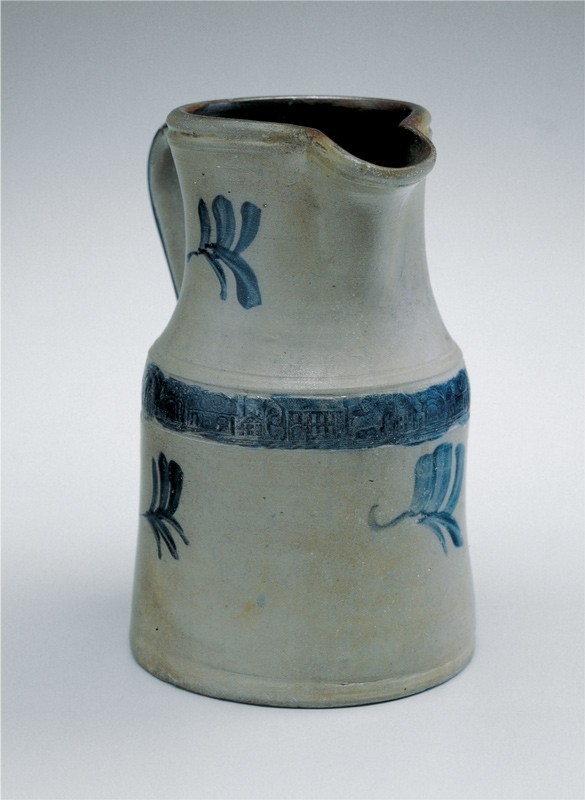
Pitcher, Morgantown, West Virginia, ca. 1870. Salt-glazed stoneware. H. 11". (Private collection.) This pitcher has a conical base, cobalt decoration, and a street-scene rouletted design. It was recovered in Grafton, West Virginia, in the early 1970s by a street crew.
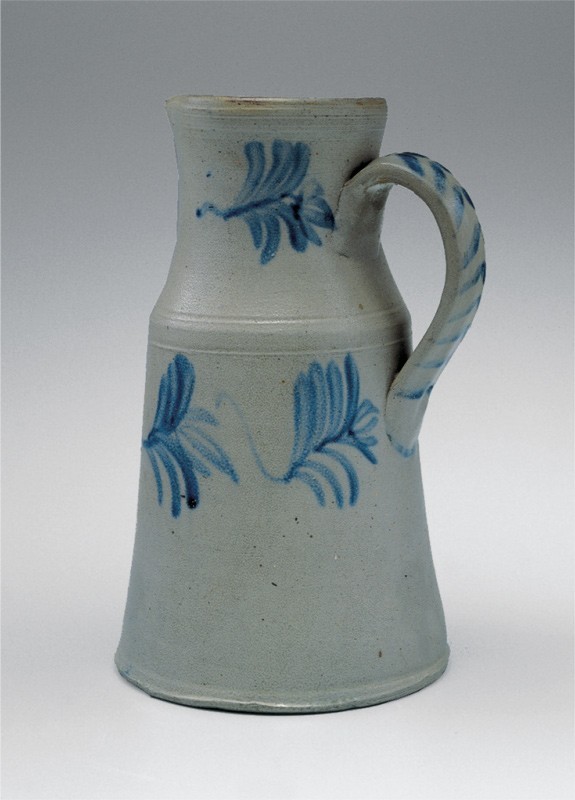
Pitcher, Morgantown, West Virginia, ca. 1870. Salt-glazed stoneware. H. 11". (Private collection.)
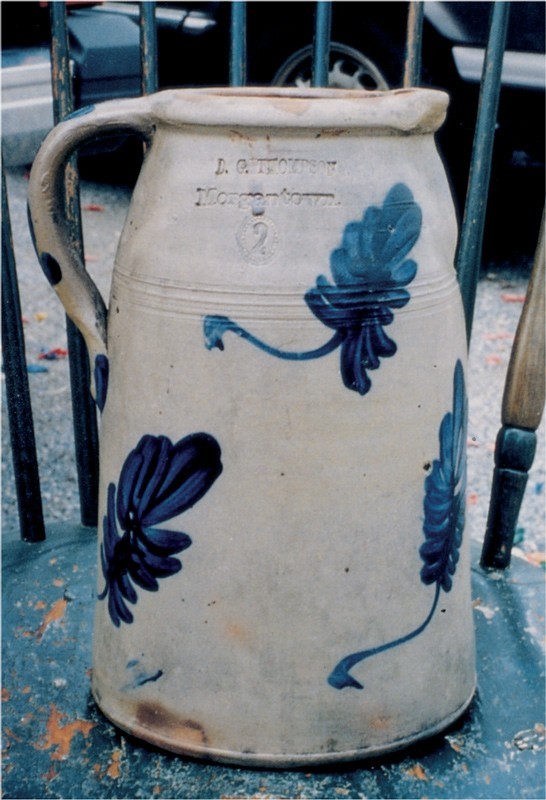
Pitcher, David Greenland Thompson, Morgantown, West Virginia, ca. 1870. Salt-glazed stoneware. H. 9". Marks, impressed on shoulder: D. G. THOMPSON / Morgantown; 2 [gallon capacity stamp within a beaded circle]. (Private collection; photo, Don Horvath.)

Detail of an extruded handle, Morgantown, West Virginia, ca. 1870. Salt-glazed stoneware. (Duez Collection.)

Jar, Morgantown, West Virginia, 1860s. Salt-glazed stoneware. H. 15". Mark: 4 [gallon capacity stamp]. (Duez Collection.) The tulip decoration is unusual for Morgantown stoneware; it is more commonly seen on wares by A. V. Boughner of Greensboro, Pennsylvania.

Detail of the embossed handles of the jar illustrated in fig. 27.

Details of embossed handles, Morgantown, West Virginia, ca. 1860. Salt-glazed stoneware. (Duez Collection.)
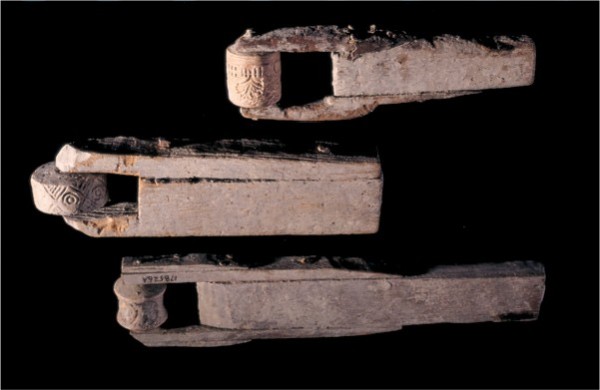
Roulettes, Thompson Pottery, Morgantown, West Virginia, 1850–1870. Wood and bisque clay. (Courtesy, National Museum of American History.)
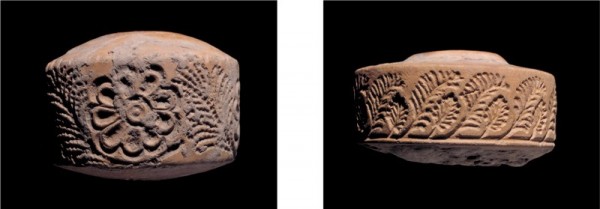
Roulettes, Thompson Pottery, Morgantown, West Virginia, 1850–1870. Bisque clay. (Courtesy, National Museum of American History.)
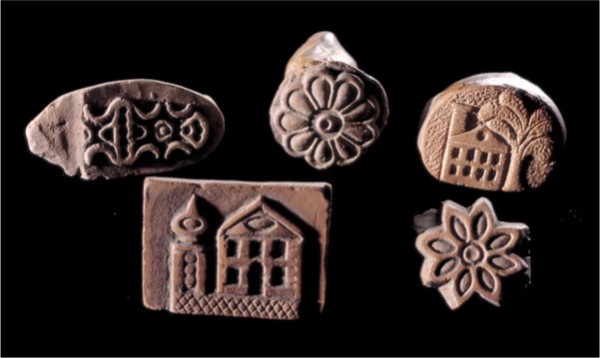
Pottery stamps, Thompson Pottery, Morgantown, West Virginia, 1850–1870. Bisque clay. (Courtesy, National Museum of American History.) These stamps were used to impress small decorative elements onto the wares.

Roulette, Thompson Pottery, Morgantown, West Virginia, 1850–1870. Bisque clay. (Courtesy, National Museum of American History.) This stamp would have been held between two fingers in order to roll the design onto the ware.
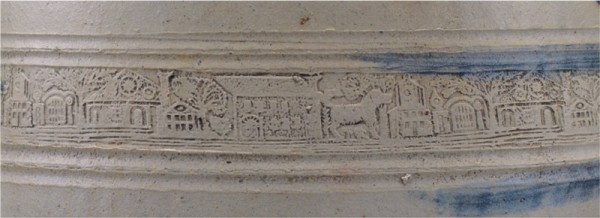
Detail of the impressed design made from the roulette illustrated in fig. 33.

Roulette, Thompson Pottery, Morgantown, West Virginia, 1850–1870. Wood and bisque clay. (Courtesy, National Museum of American History.)

Detail of the impressed design made from the roulette illustrated in fig. 35.
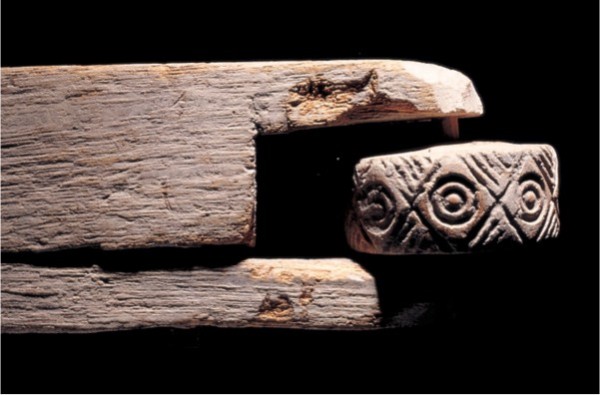
Roulette, Thompson Pottery, Morgantown, West Virginia, 1850–1870. Wood and bisque clay. (Courtesy, National Museum of American History.)

(Left) Detail of a rouletted design on an earthenware jar, Morgantown, West Virginia, ca. 1840–1854. (Private collection.) (Right) Detail of a rouletted design on a stoneware jar, Morgantown, West Virginia, 1860–1870. (Private collection.) The roulette tool used to make the design on both jars is illustrated in fig. 37.

Capacity stamps and master stamp molds, Thompson Pottery, Morgantown, West Virginia, 1850–1890. Bisque clay. (Courtesy, National Museum of American History.)
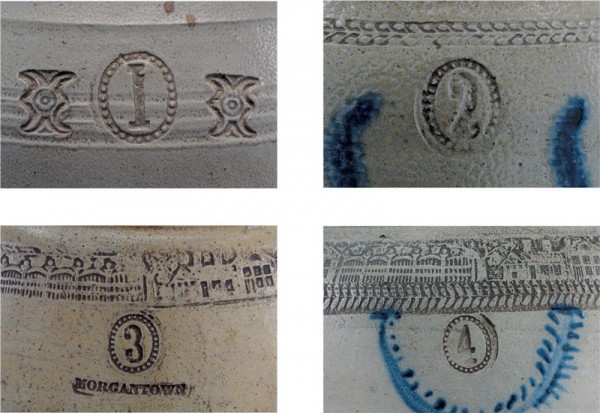
Details of gallon capacity stamps from various Morgantown jars.
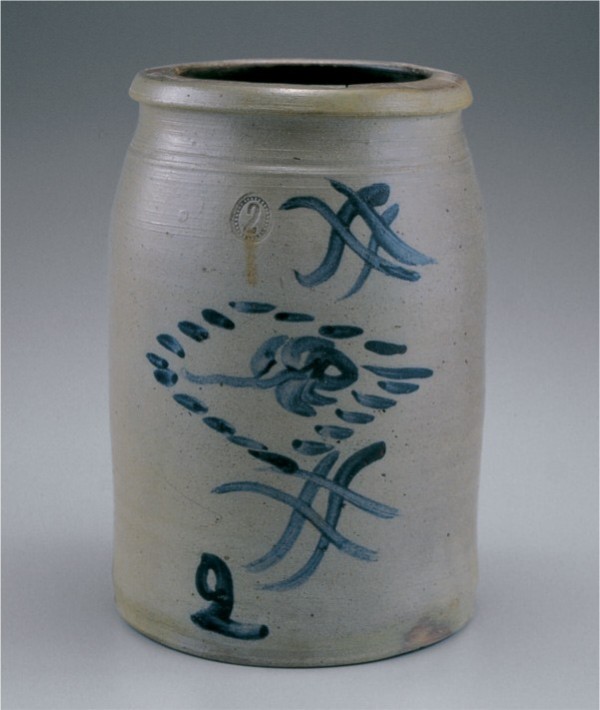
Jar, Morgantown, West Virginia, 1854–1860. Salt-glazed stoneware. H. 8 1/2". Marks: 2 [impressed gallon capacity stamp]; 2 [inscribed in cobalt]; Steam / Bote [inscribed on bottom]. (Duez Collection.) This jar is decorated with a cobalt Tic-Tac-Toe motif of the type used during the earthenware period.
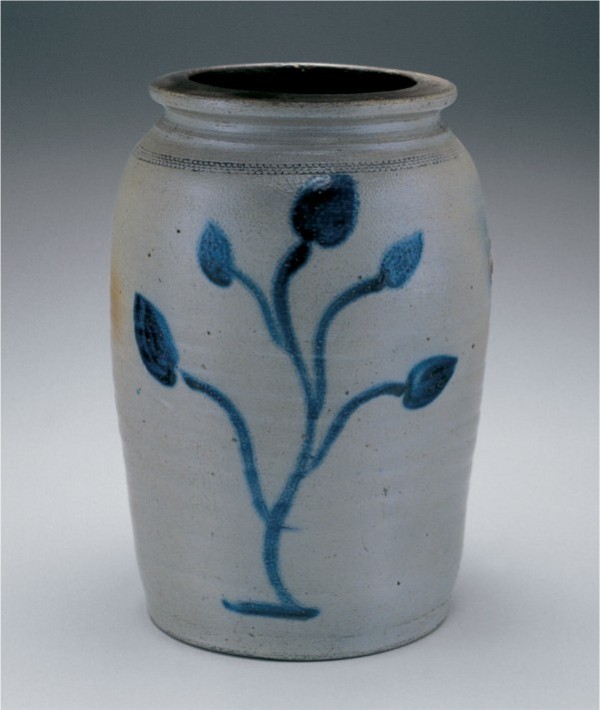
Jar, Morgantown, West Virginia, ca. 1860. Salt-glazed stoneware. H. 12 1/4". Mark: 2 [beaded gallon capacity stamp]. (Duez Collection.) A budding branch decorates this stoneware jar, which has a history in Marion County, West Virginia.
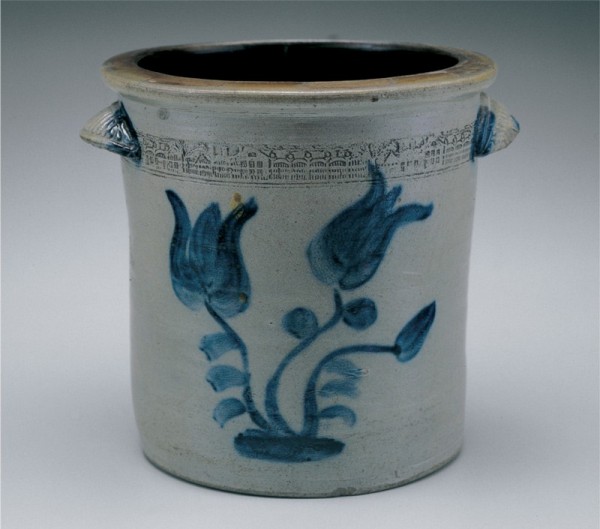
Crock, Morgantown, West Virginia, 1860–1870. Salt-glazed stoneware. H. 9 1/2". Mark: 2 [impressed gallon capacity stamp within a beaded circle]. (Duez Collection.) The floral decoration on this handled crock is enhanced with a rouletted street-scene pattern. The crock was found in Kingwood, West Virginia, where it had long been used in the making of buckwheat cakes.
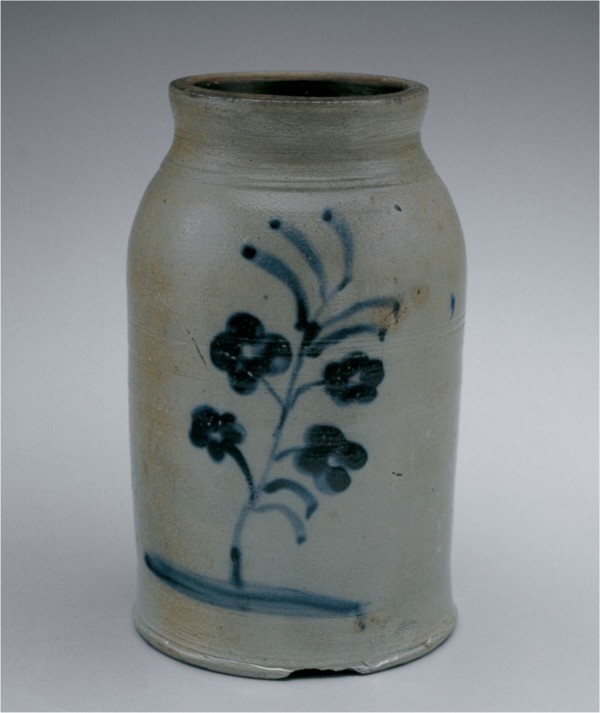
Churn, Morgantown, West Virginia, 1860–1870. Salt-glazed stoneware. H. 8 3/4". (Private collection; photo, Ken Landreth.)
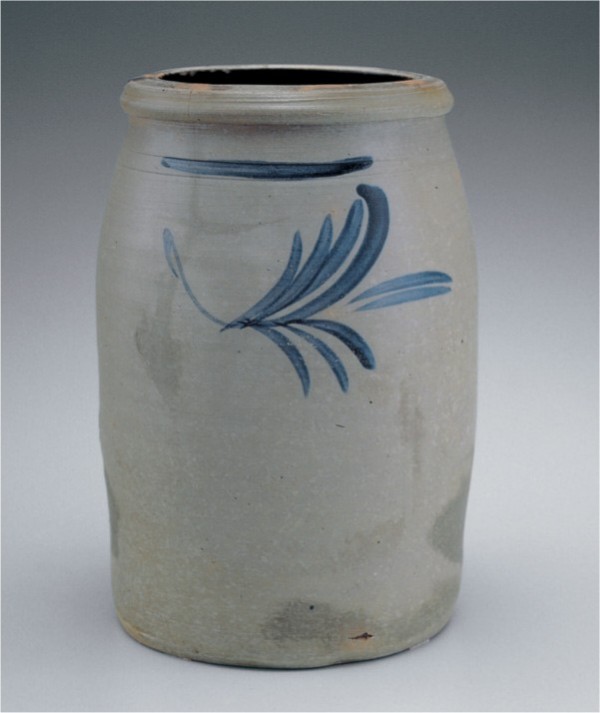
Jar, attributed to Frank W. Thompson, Morgantown, West Virginia, 1865–1875. Salt-glazed stoneware. H. 12 1/4". Mark, impressed on shoulder: F. W. Thompson / Morgantown. (Ken Landreth Collection.) This jar is the only known piece that bears what seems to be a reference to Frank W. Thompson.
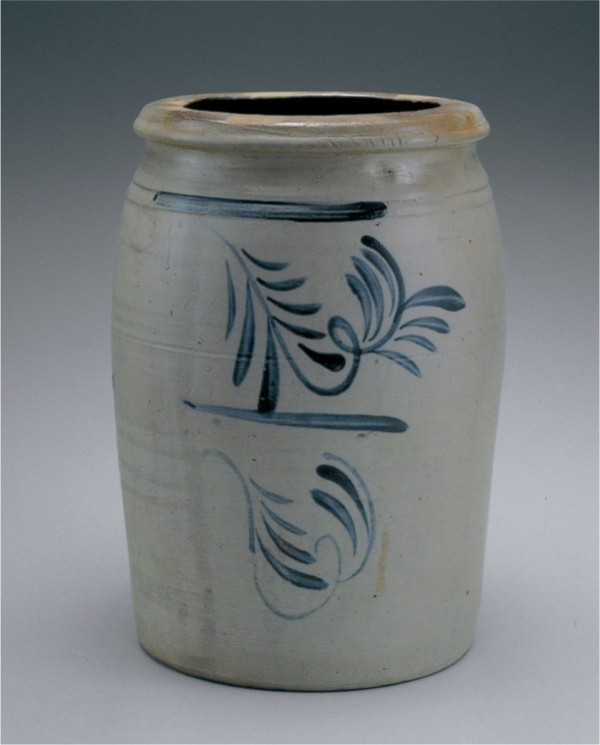
Jar, attributed to Frank W. Thompson, Morgantown, West Virginia, 1865–1875. Salt-glazed stoneware. H. 11 1/4". Mark: 2 [gallon capacity stamp within a beaded circle]. (Private collection.) Based on its similarities to the decorated jar illustrated in fig. 45, this example was probably decorated by Frank W. Thompson as well.

Jar, Morgantown, West Virginia, ca. 1860. Salt-glazed stoneware. (Private collection.) Rendered in cobalt slip on the side of this jar is a woman holding a flag, with trees on either side of her. The scene is framed at the top by a feathery arc, also in cobalt slip.
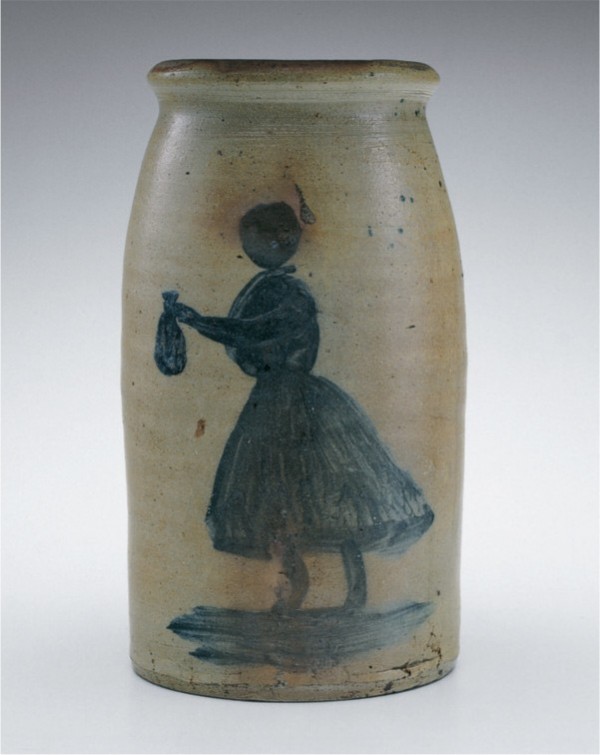
Jar, Morgantown, West Virginia, ca. 1860. Salt-glazed stoneware. H. 9 3/4". (Private collection.)
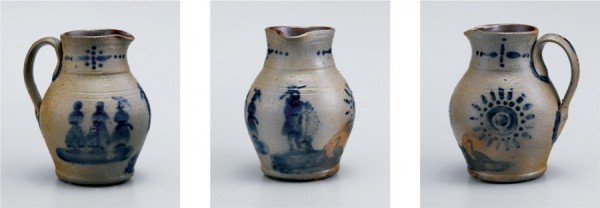
Cream pitcher, Morgantown, West Virginia, ca. 1860. Salt-glazed stoneware. H. 6 1/4". (Private collection.) This pitcher, purchased in Grafton, West Virginia, is decorated with an elaborate sunburst, four human figures, and a duck or goose.
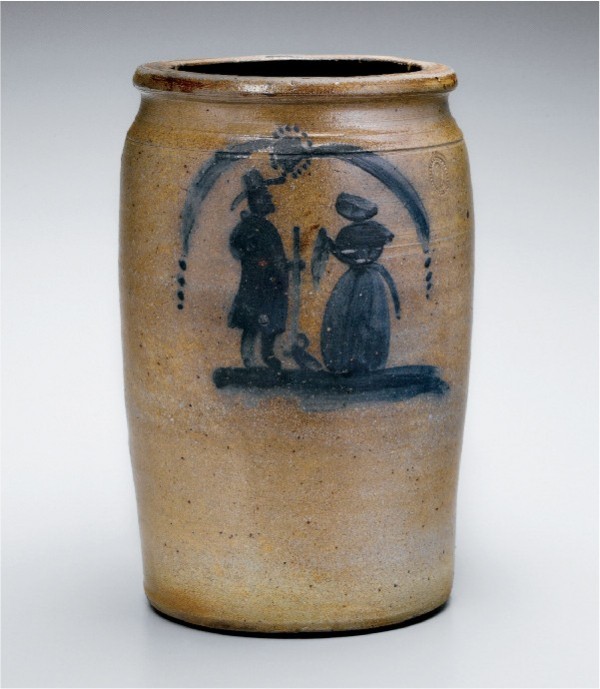
Jar, Morgantown, West Virginia, ca. 1860. Salt-glazed stoneware. Mark: 2 [gallon capacity stamp within a beaded circle]. (Private collection.)
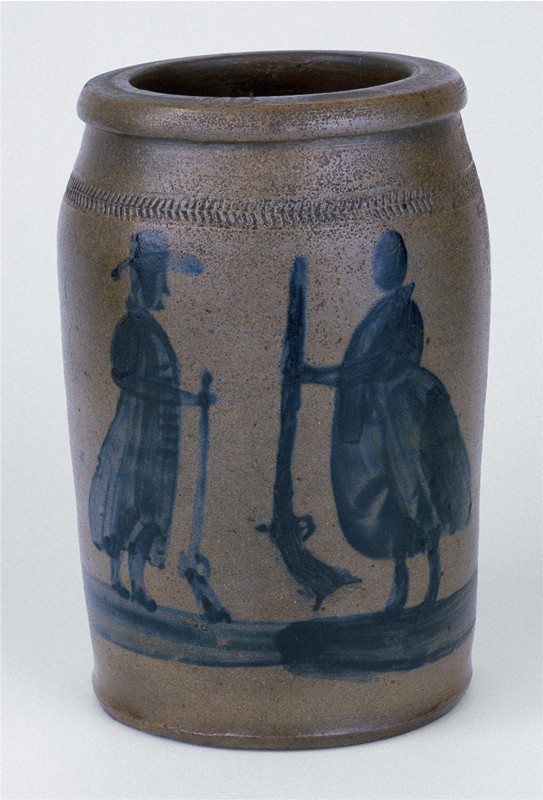
Jar, Morgantown, West Virginia, 1854–1865. Salt-glazed stoneware. H. 9 13/16". (Courtesy, Colonial Williamsburg Foundation.) This jar was found in Aurora, Preston County, West Virginia. A simple rouletted pattern with chevrons is impressed around the shoulder. The cobalt decoration shows a man and a woman, each holding a gun, facing each other. A nearly identical rendition of the figure on the left appears on the jar illustrated in fig. 50.

Jar, Morgantown, West Virginia, ca. 1860. Salt-glazed stoneware. H. 12 1/2". Mark: 2 [gallon capacity stamp within a beaded circle]. (Private collection.) This jar was found in Upshur, West Virginia. The painted decoration shows two women, one with a parasol, under a tree. The cobalt chain decoration around the shoulder is unusual for Morgantown stoneware.

Jar, Morgantown, West Virginia, ca. 1860. Salt-glazed stoneware. H. 14". Marks: 4 [gallon capacity stamp within a beaded circle]; D. G. THOMPSON / Morgantown. (Private collection.) The cobalt decoration includes a sponged pattern around the rim and a sponged crescent arcing over a woman holding a parasol. The jar was found in Fairmont, Marion County, West Virginia.

Jar, Morgantown, West Virginia, ca. 1860. Salt-glazed stoneware. H. 13 3/4". Mark: 3 [gallon capacity stamp within a beaded circle]. (Private collection.) The scene illustrated here shows three women standing between two trees. The capacity stamp is filled in with cobalt.

Jar, Morgantown, West Virginia, 1854–1860. Salt-glazed stoneware. (Private collection.) The cobalt decoration shows a whale framed within a sponged pattern.
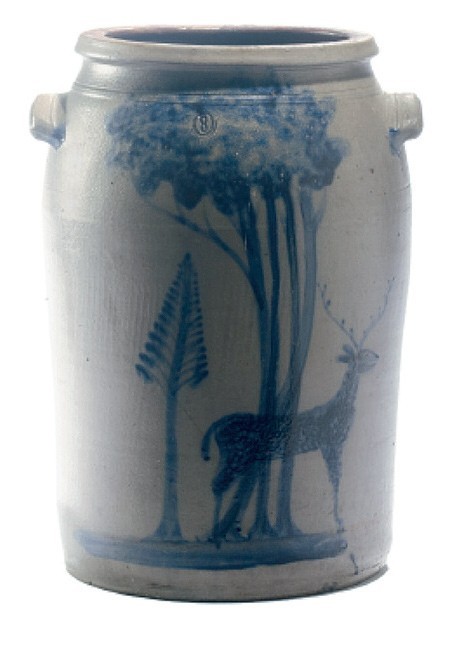
Jar, Morgantown, West Virginia, 1854–1863. Salt-glazed stoneware. H. 19". Mark: 8 [gallon capacity stamp within a beaded circle]. (Courtesy, Northeast Auctions.)

Jar, Morgantown, West Virginia, ca. 1875. Salt-glazed stoneware. H. 20 1/2". (Duez Collection.)

Flower pot, attributed to David Greenland Thompson, Morgantown, West Virginia, ca. 1885. Salt-glazed stoneware. H. 13 3/4". (Photo, courtesy of James and Karen Giuliani.)
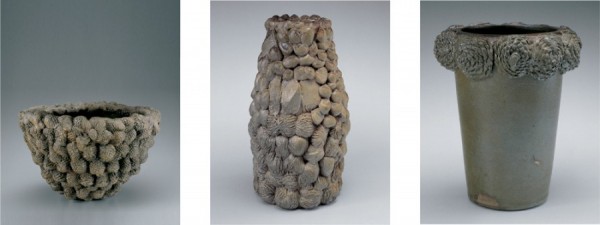
Vases and bowl, attributed to David Greenland Thompson, Morgantown, West Virginia, ca. 1885. Salt-glazed stoneware. H. of center vase 9 1/4". (Duez Collection.) Nuts, peach pits, and freshwater clams are all part of the applied decoration covering these objects.
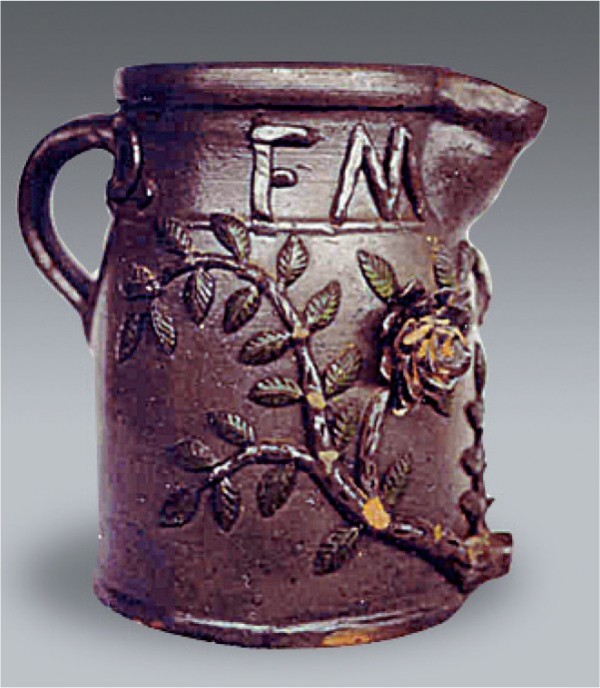
Pitcher, attributed to David Greenland Thompson, Morgantown, West Virginia, ca. 1885. Salt-glazed stoneware. H. 9". (Private collection; photo, Don Horvath.) The pitcher is covered with applied leaves and stems. Applied lettering around the neck spells out “F. M. Haymond,” one of Thompson’s relatives.
